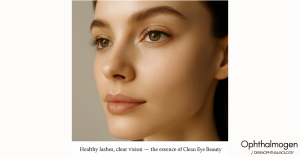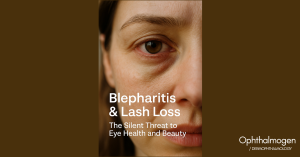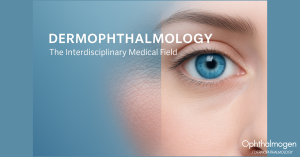
Introduction
Dark circles often appear or worsen after surgical procedures on the nose, eyelids, or eyes. While frequently considered a purely cosmetic issue, in reality they represent a pathological phenomenon linked to edema, microcirculation disturbances, and inflammation.
Dermophthalmology highlights this dimension, offering new solutions for both ocular health and aesthetic restoration.
Why Do Dark Circles Appear with Age?
- Ciliary muscle fatigue → reduced blood supply.
- Poor microcirculation → less oxygen delivery, more shadows.
- Dry eye & inflammation → tired, heavy-looking eyes.
- Thinning skin & loss of collagen/fat → veins and vessels become more visible.
- Co-existing conditions (allergies, blepharitis, thyroid disease, glaucoma).
Epidemiology
- 40% of children with allergic rhinitis present dark circles.
- 50% of women aged 35–60 have tried cosmetic solutions (concealer, filler, laser).
- 70% of adults over 45 notice worsening dark circles with age.
- Very few know that dark circles may also have an ocular origin.
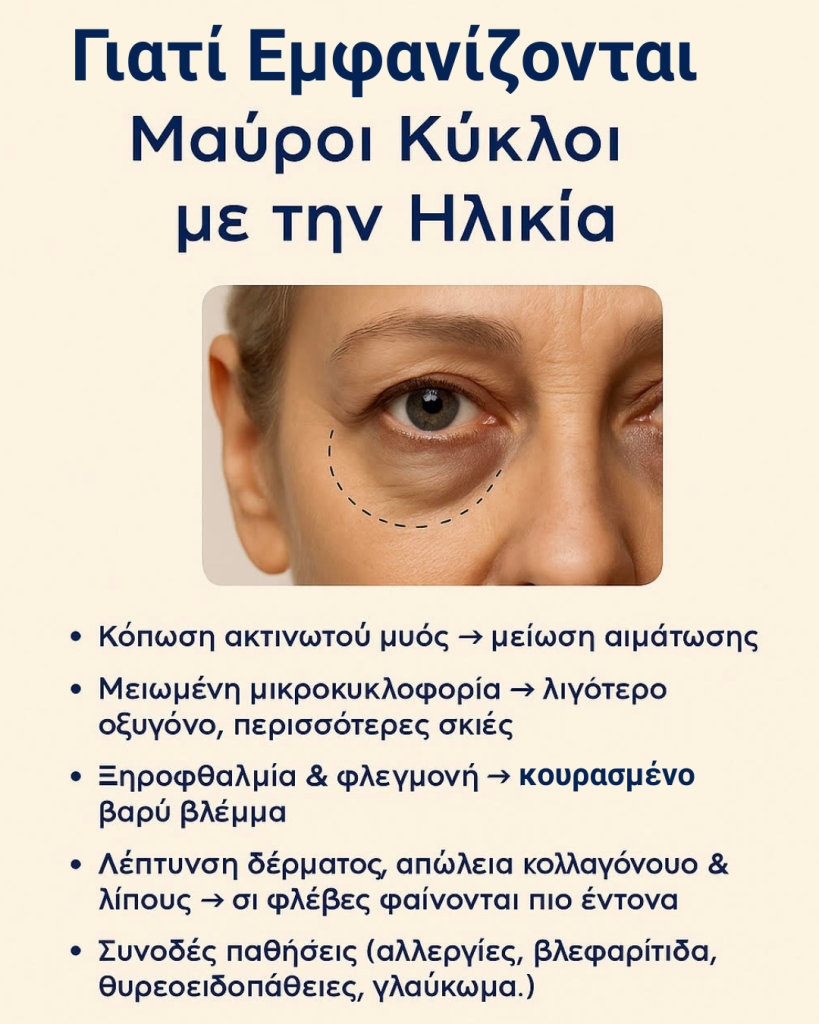
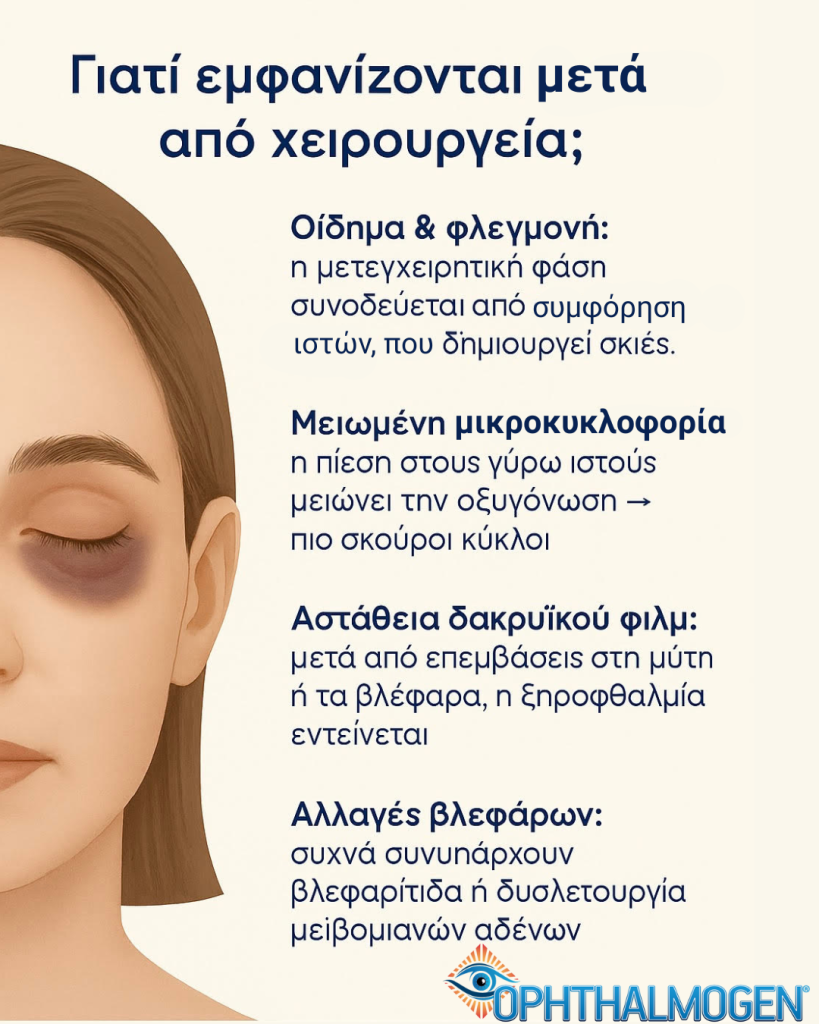
Why Do They Appear After Surgery?
Edema & inflammation → post-operative congestion creates shadows.
Reduced microcirculation → tissue pressure decreases oxygenation, producing darker circles.
Tear film instability → nasal or eyelid surgeries often aggravate dry eye.
Eyelid changes → blepharitis or Meibomian gland dysfunction frequently coexist.
Dark Circles After Eye & Facial Procedures
Surgical procedures can leave temporary or permanent marks around the eyes, often in the form of dark circles:
- LASIK & Refractive Surgery
Post-operative dry eye burdens the ocular surface, making dark circles more pronounced.
- Blepharoplasty
Bruising and swelling mimic dark circles. Without proper care, long-term hyperpigmentation may persist.
- Cataract Surgery
While not directly affecting eyelids, post-operative dry eye and prolonged use of steroid/NSAID drops may trigger irritation and worsen circles.
- Rhinoplasty
Trauma in the nasal region often affects the periorbital area, leading to temporary or prolonged dark circles.
- Fillers & Botox
Incorrect application may cause vascular congestion or shadowing.
The Double Nature of Dark Circles
Aesthetic side: Concealers, fillers, and lasers help temporarily but do not address underlying causes.
Pathological side :
- Allergic rhinitis & conjunctivitis → “allergic shiners.”
- Blepharitis & Demodex → chronic inflammation.
- Dry eye disease → ocular surface inflammation.
- Glaucoma therapy (prostaglandin analogues) → periocular fat atrophy & pigmentation.
- Thyroid disease → puffiness & shadowing.
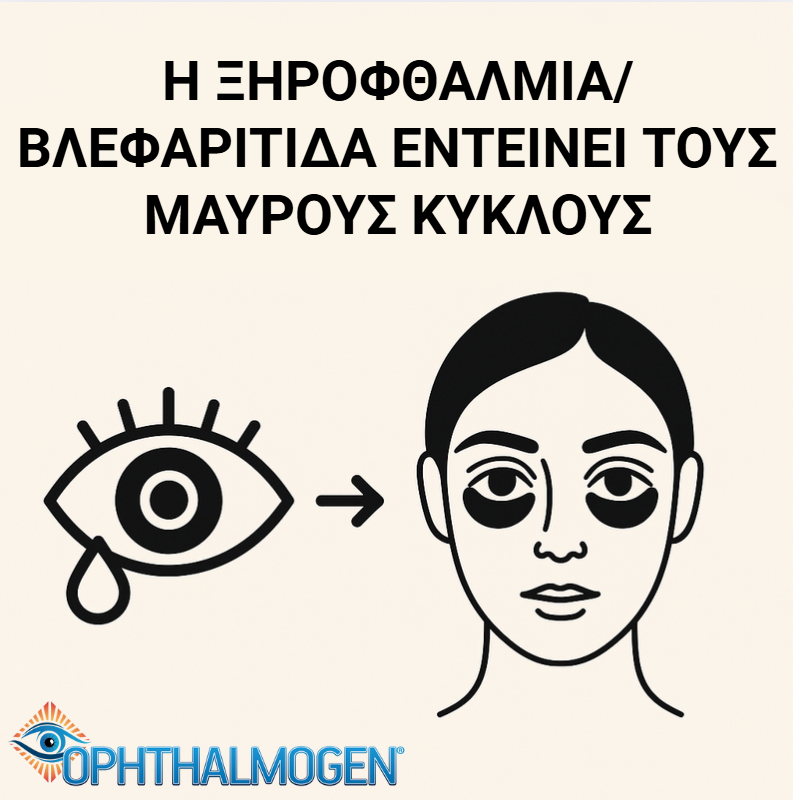
Dermophthalmology as the Solution

Case Studies
Female, 42 years old – after rhinoplasty: persistent dark circles. With EYE10 + Gel + Navi NaCl5% → reduced edema, clearer gaze.
Male, 50 years old – after LASIK: dry eye & dark circles. With Ophthalmogen EYE10 + Spray + Navitae → improved tear film, brighter eyes.
- Thermotherapy (Ophthalmogen EYE10) → relieves Meibomian gland obstruction, restores tear film stability, and improves microcirculation.
- Eyelid massage (Ophthalmogen Gel) → enhances microcirculation, reduces inflammation, controls Demodex.
- Eyelid spray (Ophthalmogen Spray) → hydration and protection of eyelids/eyelashes with vitamins, tea tree oil & natural extracts.
- Lid hygiene (foam or wipes, e.g., Naviblef) → removes debris, allergens, and microbes.
- Artificial tears → Navi NaCl 5% (hydration + anti-edema effect), Visionlux Plus (hydration + B12), Thealoz DUO (antioxidant with trehalose), Navitae Plus (antioxidant protection), Systane Hydration, Optive Plus.
- Nutritional supplements (Allvita Eyes capsules) → nourish retina, ocular muscles, Meibomian glands & tear film, providing antioxidant protection.
- Dermalife 520 → Anti-puffiness hydrogel undereye patches with best result when used after Ophthalmogen EYE10 treatment

FAQ
Are dark circles after surgery normal?
Common, but not inevitable.
Can they be prevented?
Yes — with proper post-operative care and Dermophthalmology hygiene, intensity can be reduced.
When should I see an ophthalmologist?
If circles are accompanied by significant tearing, blurred vision, or pain.
Conclusion
Dark circles after surgical procedures are not merely a cosmetic concern. They signal ocular fatigue, inflammation, and tissue stress.
Dermophthalmology provides the answer: eyelid care, eyelash health, and ocular surface hydration → for healthier eyes, a brighter gaze, and improved quality of life.
Dermophthalmology is the new medical specialty we have introduced (learn more at www.dermophthalmology.com)




